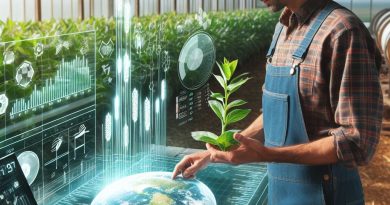Smart Farming: The Rise of Agri Robots
Last Updated on March 2, 2024
Introduction
Smart farming has transformed the traditional agricultural practices, bringing numerous benefits to farmers.
By integrating technology into farming, productivity and efficiency have significantly increased.
Yield monitoring, soil mapping, and livestock monitoring are some examples of smart farming techniques that have positively impacted the industry.
However, one emerging trend that is revolutionizing smart farming is the utilization of agricultural robots.
These robots are designed to perform various tasks with precision, reducing the need for manual labor and freeing up farmers’ time.
With the ability to perform repetitive tasks tirelessly, agri robots can significantly improve efficiency and productivity in farming operations.
This blog post aims to delve into the rise of agri robots and their impact on smart farming.
We will explore the various types of agricultural robots available in the market and their specific functions.
From automated drones for crop monitoring to robotic harvesters, these machines are transforming the way agriculture is conducted.
Furthermore, we will discuss the benefits of using agri robots, such as increased yield, reduced labor costs, and improved resource management.
We will also address the challenges and limitations that come with implementing agri robots in farming operations.
Basically, this blog post will provide insights into the rising trend of agri robots in smart farming.
It will highlight the advantages they bring to the agriculture sector and discuss their potential for future growth and development.
Stay tuned to discover how agri robots are shaping the future of farming.
The Need for Agri Robots
Agriculture has always played a crucial role in human civilization, providing sustenance and livelihood to billions of people.
However, traditional farming methods face several challenges that hinder the efficient production of food.
Challenges faced by traditional farming methods
Limited availability of arable land and depleting soil quality.
Inefficient use of water resources and growing scarcity of freshwater.
Dependence on chemical fertilizers and pesticides, harming both the environment and human health.
Labour-intensive processes leading to rising costs and difficulty in attracting farm labor.
Difficulties in monitoring and managing crop diseases, pests, and weeds.
Increasing demand for food production
The world’s population is steadily growing, and it is projected to reach 9 billion by 2050.
This surge in population necessitates a significant increase in food production to meet the rising demand.
Importance of precision agriculture
Precision agriculture refers to the use of modern technologies to optimize agricultural practices.
It involves collecting and analyzing data to make informed decisions for maximizing crop yield, minimizing resource wastage, and reducing environmental impact.
The role of agri robots in addressing these needs
Agri robots, also known as agricultural robots, are advanced machines equipped with autonomous capabilities and sensors.
They bring automation and precision to farming, revolutionizing traditional methods.
- Improved efficiency: Agri robots can perform various tasks more quickly and accurately than humans, enhancing the overall efficiency of farming operations.
- Optimized resource usage: By utilizing sensors and artificial intelligence, these robots can precisely manage water, fertilizers, and pesticides, minimizing waste and ensuring optimal crop growth.
- Monitoring and management: Agri robots can monitor crops, detect diseases, pests, and weeds at an early stage, enabling targeted interventions and reducing crop losses.
- Enhanced data collection and analysis: These robots can gather vast amounts of data on soil conditions, weather patterns, and other important parameters, allowing farmers to make data-driven decisions for better outcomes.
- Labour shortage solution: With the global decline in farm labor availability, agri robots offer a viable solution by automating various farm tasks and reducing dependency on human labor.
The adoption of agri robots in modern farming practices is steadily increasing to overcome the limitations of traditional methods.
These robots have the potential to revolutionize the agriculture industry by increasing productivity, reducing environmental impact, and helping meet the growing demand for food.
Read: Farming Apps: Top Picks for 2024
Types of Agri Robots
Agri robots are revolutionizing the farming industry, providing efficient and effective solutions to various agricultural tasks.
These robots are designed to perform different functions, aiding farmers in improving crop yield, minimizing labor costs, and enhancing overall productivity.
Field Robots
Field robots have become increasingly popular in modern agriculture.
These robots are equipped with advanced sensors and imaging technologies to monitor and analyze crops.
They can detect crop diseases, identify nutrient deficiencies, and assess overall plant health.
Farmers can use this data to make informed decisions about watering, fertilizing, and managing crops effectively.
Automated planting and harvesting are key tasks that agri robots excel at.
These robots can plant seeds at precise depths and intervals, ensuring even distribution and optimal growth.
Similarly, during the harvesting process, robots can identify ripe crops and pick them efficiently, reducing human labor and increasing productivity.
Weed control and pesticide application are significant challenges faced by farmers.
Agri robots provide a solution by autonomously identifying and eliminating weeds.
With their precision spraying capabilities, robots can target specific areas, minimizing the use of herbicides and reducing environmental impact.
Drone Technology in Farming
Drones are increasingly being used in agriculture for aerial crop surveillance and mapping.
Equipped with high-resolution cameras and sensors, drones can capture detailed images of fields, detecting issues such as nutrient deficiencies, soil variations, and irrigation problems.
This valuable information allows farmers to take timely actions to optimize crop health and yield.
Effective water and fertilizer management are essential for sustainable farming.
Drones can help farmers monitor irrigation systems, allowing them to identify areas with water stress and efficiently distribute water resources.
By analyzing soil conditions, drones can also aid in precision fertilizer application, ensuring optimal nutrient levels in different areas of a field.
Livestock Robots
Livestock robots are revolutionizing animal husbandry practices, providing automated solutions for feeding and milking.
These robots can automatically dispense food, minimizing labor and ensuring animals receive the necessary nutrition.
Additionally, automated milking systems have sensors that detect when cows need to be milked, providing convenience and reducing manual effort.
Monitoring animal health and behavior is crucial for livestock management.
By using sensors and cameras, livestock robots can observe and collect data on animal activities, such as eating, drinking, and movement patterns.
This information helps farmers identify signs of illness, distress, or abnormal behavior, allowing for timely intervention and enhanced animal welfare.
In fact, the rise of agri robots brings incredible advancements to the farming industry.
From field robots performing crop monitoring and analysis to drones aiding in aerial surveillance and livestock robots automating feeding and milking, these technologies are transforming agriculture.
By harnessing the power of robotics, farmers can increase efficiency, reduce costs, and ultimately achieve sustainable and productive farming practices.
Read: Drone Imaging in Farms: A New Perspective
Benefits of Agri Robots
Agri robots are revolutionizing the agricultural industry, offering numerous benefits to farmers and the overall food production system.
Let’s explore some of the key advantages:
Increased efficiency and productivity
Agri robots have the capability to perform tasks in a much faster and more accurate manner compared to manual labor.
They can efficiently carry out activities such as seeding, planting, harvesting, and crop monitoring.
This increased efficiency enhances overall productivity, allowing farmers to accomplish more in less time.
Enhanced sustainability and resource management
One of the major challenges in agriculture is the efficient use of resources like water, fertilizers, and pesticides.
Agri robots can be equipped with sensors and artificial intelligence algorithms that enable precise and targeted application of these resources.
This results in reduced waste and environmental impact, contributing to enhanced sustainability.
Reduced labor costs and improved safety
Traditionally, farming has relied heavily on manual labor, which can be expensive and time-consuming.
However, agri robots eliminate the need for human workers in various farming tasks.
This not only reduces labor costs for farmers but also improves safety by minimizing accidents and injuries associated with working in hazardous agricultural environments.
Improved crop quality and yield
Agri robots are equipped with advanced technologies that enable precise and consistent cultivation practices.
They can ensure optimal seed spacing, uniform application of fertilizers and pesticides, and timely harvesting.
These factors contribute to improved crop quality, resulting in higher market value and increased yield.
Opportunities for data-driven decision making
Agri robots collect vast amounts of data during their operations, such as soil conditions, crop health, and weather patterns.
This data can be analyzed using machine learning algorithms to derive valuable insights.
Farmers can make data-driven decisions regarding irrigation, pest control, and other farming practices, leading to optimized yields and resource allocation.
In short, agri robots offer a multitude of benefits for farmers and the agriculture industry as a whole.
They increase efficiency and productivity, enhance sustainability through resource management, reduce labor costs, improve crop quality and yield, and provide opportunities for data-driven decision making.
As technology continues to advance, the role of agri robots in smart farming will only become more prominent.
Read: Farm Data Analysis: Improving Yields

Challenges and Limitations
High initial investment and maintenance costs
One of the major challenges faced in the adoption of agri robots is the high initial investment required.
The cost of purchasing and deploying these advanced machines can be a significant barrier for farmers.
Moreover, the maintenance costs of these robots can add up over time.
Regular servicing, software updates, and repairs can all contribute to the overall expenses, making it difficult for some farmers to afford and sustain their use.
Integration with existing farming practices
Integrating agri robots with existing farming practices can be complex.
Many traditional farming methods may not align with the capabilities and use of robotic systems.
Farmers need to adapt their practices and workflows to accommodate the presence of robots.
This process may require reconfiguring fields, updating infrastructure, and obtaining proper training on how to effectively utilize the robots.
Need for advanced technical skills
The operation and maintenance of agri robots require advanced technical skills.
Farmers who have primarily relied on manual labor may face challenges in acquiring the necessary expertise to work with these high-tech machines.
Training programs and workshops to educate farmers on robot operation, programming, and troubleshooting should be made accessible to ensure their successful incorporation into farming practices.
Ethical concerns and potential environmental impacts
The rise of agri robots raises ethical concerns and potential environmental impacts.
Some argue that the increased reliance on technology may lead to a loss of human touch in agriculture.
Additionally, there are concerns related to the potential environmental impacts of agri robots.
The use of robot-controlled spraying systems, for example, may raise questions about the proper and safe application of pesticides.
Proper regulations and guidelines need to be in place to address these concerns and ensure that the adoption of agri robots is accompanied by responsible and sustainable practices.
In essence, while the rise of agri robots in smart farming offers numerous benefits, there are significant challenges and limitations that need to be addressed.
High initial investment and maintenance costs, integration with existing farming practices, the need for advanced technical skills, and ethical concerns are just a few of the key obstacles that farmers and policymakers must consider.
By acknowledging the limitations and actively working to overcome them, the full potential of agri robots can be realized in the future of agriculture.
Read: Nano-Tech in Farming: Small but Mighty
Current Examples and Success Stories
Case studies of farmers utilizing agri robots
- Farmer John, from Ohio, has successfully incorporated agri robots into his crop cultivation process.
- By using autonomous robots for seed planting, watering, and pest control, he has seen a significant increase in crop yield.
- The robots are equipped with advanced sensors and mapping technology, allowing them to work efficiently and accurately.
Examples of successful implementation and outcomes
- Farming company XYZ implemented agri robots for harvesting strawberries and achieved a 30% increase in productivity.
- The robots were programmed to identify ripe strawberries, reducing the need for manual labor and speeding up the process.
- As a result, the company not only saved costs but also improved the quality and freshness of their strawberries.
Positive impact on small-scale and large-scale farming operations
- Agri robots have leveled the playing field for small-scale farmers, allowing them to compete with larger operations.
- The automation provided by robots has reduced the need for a large workforce, saving costs for both small and large farms.
- With agri robots, farmers can optimize their resources more efficiently, leading to increased profitability and sustainability.
- Large-scale farming operations have experienced improved efficiency and productivity by incorporating agri robots.
- These robots can cover large areas of land quickly and accurately, performing tasks more effectively than human labor.
- The precision and consistency provided by robots result in better crop quality and reduced waste.
- Moreover, agri robots can operate around the clock, ensuring continuous and uninterrupted farming operations.
Overall, the implementation of agri robots in farming has shown promising results and success stories.
As more farmers embrace this technology, we can expect further advancements and benefits for the agriculture industry.
With increased crop yield, reduced costs, and optimized resource usage, agri robots are revolutionizing farming operations for both small-scale and large-scale farmers.
You Might Also Like: AI in Farms: Precision Agriculture’s Rise
Future Possibilities and Trends
Advancements in artificial intelligence and machine learning
- As technology continues to evolve, agri robots can benefit from advancements in artificial intelligence and machine learning.
- AI algorithms can help robots make autonomous decisions based on real-time data, improving efficiency and productivity.
- Machine learning can enable robots to learn from past experiences and adapt their actions to different farming situations.
- With improved AI capabilities, agri robots can enhance precision farming techniques and optimize resource utilization.
Integration of agri robots with Internet of Things (IoT)
- Agri robots can be connected to IoT devices, enabling seamless data exchange and communication between various farming systems.
- Integration with IoT can provide continuous monitoring of crops, weather conditions, and soil moisture levels.
- Real-time data collected by agri robots can be used to analyze trends, predict yields, and make informed decisions.
- IoT integration can also facilitate remote control and monitoring of agri robots, increasing operational flexibility and reducing physical labor.
Robotics and automation in vertical farming
- Vertical farming, a sustainable farming practice, can greatly benefit from the use of agri robots for automation.
- Robots can perform tasks such as seeding, watering, and harvesting in vertical farming systems.
- Vertical farming facilities can utilize robots to optimize space utilization and increase crop yield.
- Agri robots can ensure consistent and precise application of nutrients and provide real-time monitoring of plant health in vertical farms.
Potential role in addressing global food security challenges
- Agri robots have the potential to play a crucial role in addressing global food security challenges.
- By increasing efficiency and productivity, agri robots can help meet the growing demand for food.
- Robots can work around the clock, reducing labor requirements and improving crop availability.
- Autonomous agri robots can operate in harsh environments and remote areas, expanding agricultural production possibilities.
In review, the future of agri robots presents exciting possibilities and trends.
Advancements in artificial intelligence and machine learning can enhance the capabilities of these robots, enabling autonomous decision-making and resource optimization.
Integration with IoT devices can enable real-time data collection and analysis, leading to informed farming practices.
The adoption of agri robots in vertical farming can revolutionize the industry by increasing productivity and space utilization.
Moreover, these robots have the potential to address global food security challenges by increasing efficiency, reducing labor requirements, and operating in remote areas.
As technology continues to advance, we can expect agri robots to play a significant role in shaping the future of smart farming.
Discover More: Next-Gen Greenhouses: Automation in Play
Conclusion
Recap of Agri Robots
The rise of agri robots signifies a monumental shift in agriculture, heralding increased efficiency, productivity, and sustainability.
These robots, equipped with advanced technology, have become indispensable tools for modern farmers.
Encouragement for Farmers
Farmers are urged to explore and embrace the benefits of smart farming, leveraging agri robots to optimize their operations.
By integrating these innovative technologies into their practices, farmers can significantly improve yields while reducing labor and resource costs.
Closing Statement
Overall, agri robots have the potential to revolutionize the agricultural industry.
Their adoption promises to streamline processes, enhance environmental stewardship, and ensure food security for future generations.
As we continue to advance in technology, embracing agri robots represents a crucial step towards a more sustainable and efficient agricultural future.


